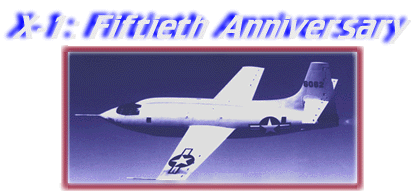
Bibliography


Beginning in 1946, two XS-1 experimental research aircraft (later redesignated X-1s) conducted pioneering tests at Muroc Army Air Field (now Edwards Air Force Base) in California to obtain flight data on conditions in the transonic speed range. These early tests culminated on October 14, 1947, in the first piloted flight faster than Mach 1.0, the speed of sound.
The XS-1 was the first high-speed aircraft built purely for aviation research purposes. The model was never intended for production. The XS-1 was designed largely in accordance with specifications provided by the National Advisory Committee for Aeronautics (NACA) [now National Aeronautics and Space Administration], paid for by the Army Air Forces, and built by Bell Aircraft Inc. The XS-1 #2 (serial number 46-063) was flight tested by the NACA to provide design data for later production high-performance aircraft.
The research techniques used in the X-1 program became the pattern for all subsequent X-craft projects. The NACA X-1 procedures and personnel also helped lay the foundation of America's space program in the 1960s. The X-1 project defined and solidified the post-war cooperative union between U.S. military needs, industrial capabilities, and research facilities. The flight data collected by the NACA in the X-1 tests then provided a basis for American aviation supremacy in the latter half of the 20th century.
As a result of the X-1's initial supersonic flight, the National Aviation Association voted its 1948 Collier Trophy to be shared by the three main participants in the program. Honored at the White House by President Truman were Lawrence "Larry" Bell for Bell Aircraft, Captain Charles E. "Chuck" Yeager for piloting the flights, and John Stack of NACA for the NACA contributions.

Updated September 18, 1997
histinfo@hq.nasa.gov
or
Steve Garber, NASA History Office,
steve.garber@hq.nasa.gov